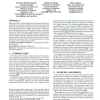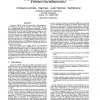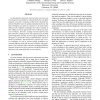19 search results - page 2 / 4 » Transient-Fault Recovery for Chip Multiprocessors |
GLVLSI
2010
IEEE
13 years 5 months ago
2010
IEEE
Relentless CMOS scaling coupled with lower design tolerances is making ICs increasingly susceptible to wear-out related permanent faults and transient faults, necessitating on-chi...
DSN
2007
IEEE
13 years 11 months ago
2007
IEEE
Aggressive CMOS scaling will make future chip multiprocessors (CMPs) increasingly susceptible to transient faults, hard errors, manufacturing defects, and process variations. Exis...
DSN
2006
IEEE
13 years 11 months ago
2006
IEEE
As chip densities and clock rates increase, processors are becoming more susceptible to transient faults that can affect program correctness. Computer architects have typically ad...
ISCA
2007
IEEE
13 years 11 months ago
2007
IEEE
High availability is an increasingly important requirement for enterprise systems, often valued more than performance. Systems designed for high availability typically use redunda...
IEEEPACT
2007
IEEE
13 years 11 months ago
2007
IEEE
Under current worst-case design practices, manufacturers specify conservative values for processor frequencies in order to guarantee correctness. To recover some of the lost perfo...



